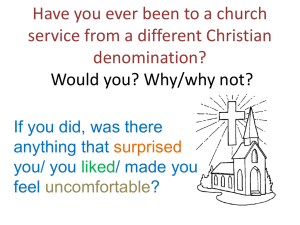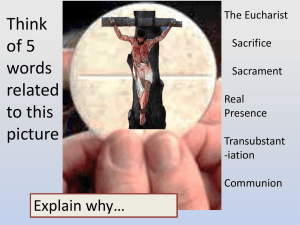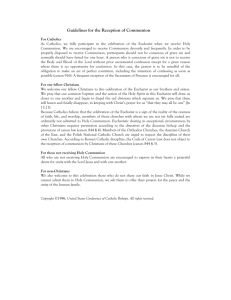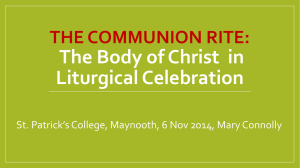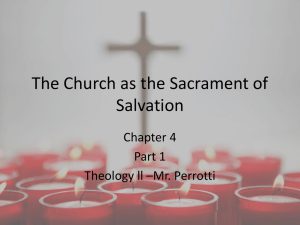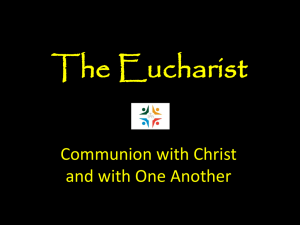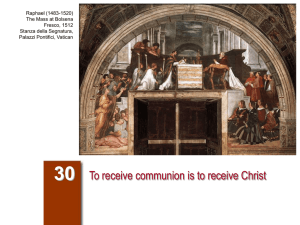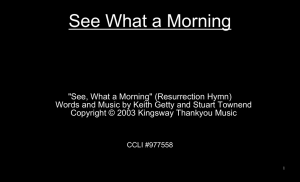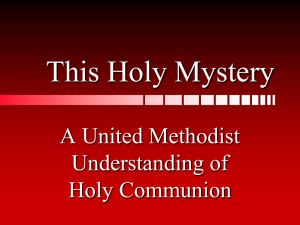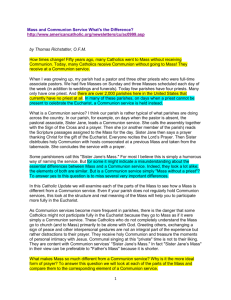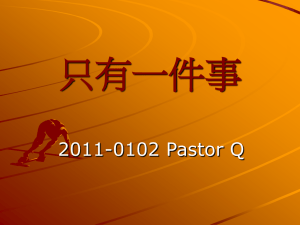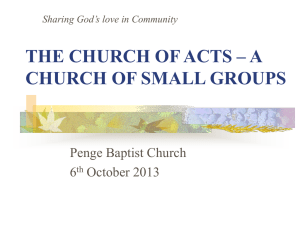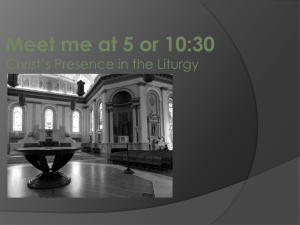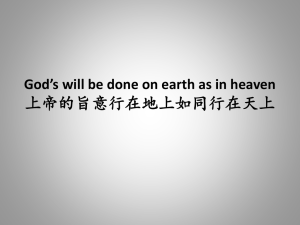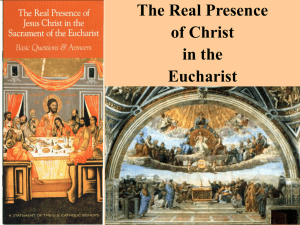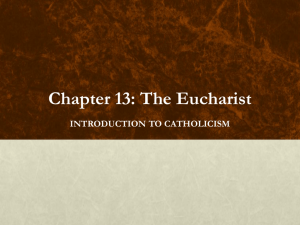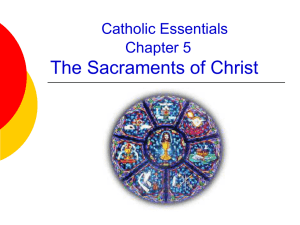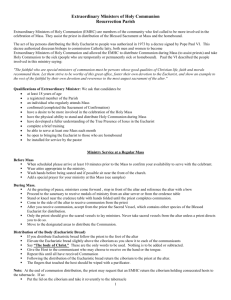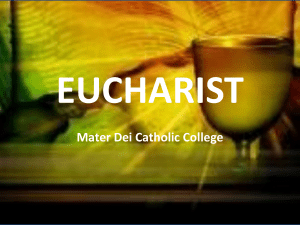Sacraments of Initiation: The Eucharist
advertisement
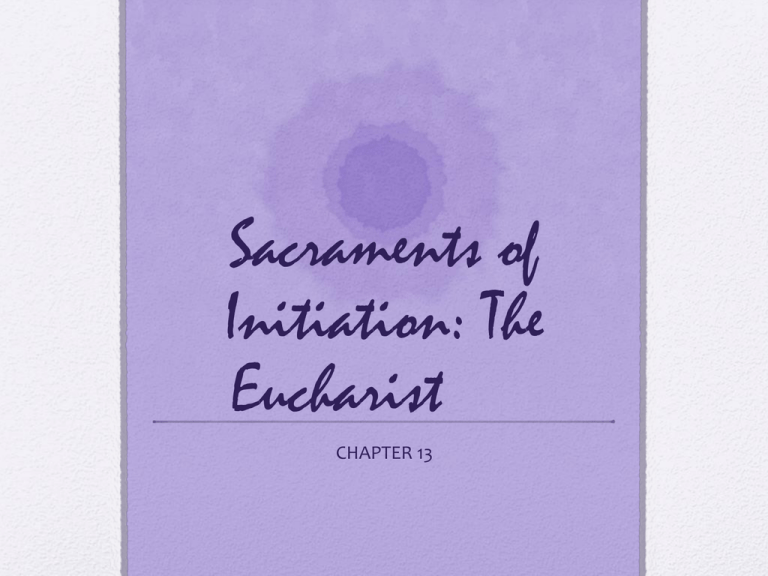
Sacraments of Initiation: The Eucharist CHAPTER 13 Eucharist: giving Thanks • OLD TESTAMENT ROOTS • The Passover Lamb • Manna in the wilderness • Todah – thank offering • Instituted by Christ • The Last Supper • A pledge of his love • The New Covenant The Real Presence • Gospel writers use “to be” –this is a literal connotation, not a metaphorical one • “Do this in memory of me” gives Apostles authority to transform bread and wine into his body and blood • Substance is changed by Holy Spirit acting through Christ. The Eucharist is Christ, under the appearance of bread and wine. The Real Presence • Our human senses perceive bread and wine, but we know through faith that Christ is truly present. • The change of bread and wine is referred to as transubstantiation (CCC#1376) • Really, truly, substantially present • Sts. Ignatius of Antioch and Iranaeus of Lyons The Real Presence • Let’s watch a summary from a Youth Minister to recap: • http://www.youtube.com/watch?v=gs20m1mN Gdw Miracles of the Eucharist • Lanciano, Italy: 8th century • Bread and wine changed to flesh and blood • Flesh has been tested; 1981 determined to be heart tissue • Bolsena, Italy: 13th century • Blood seeped from the host • Host and linen enshrined in Cathedral Miracles of the Eucharist • Amsterdam, Holland: 14th century • Viaticum- Communion given on deathbed • Unburned and cold to touch after being placed in fire • Siena, Italy: 18th century • Ciborium with hosts stolen • Returned and un-deteriorated 300 years later • These miracles are private revelations, and not added to the Deposit of Faith Celebration of Eucharist • A Holy Sacrifice • The Holy Sacrifice of the Mass re-presents Christ’s sacrifice on the Cross • Christ’s sacrifice was perfect, only needing to be offered once • Eucharist is a “memorial” and a re-presentation • We are able to participate in Christ’s Sacrifice in the Mass Celebration of Eucharist • Celebrated as part of Mass. • Outside of Mass, adoration, Benediction, and Eucharistic processions allow Catholics to worship the Real Presence of Jesus • May be received outside of Mass by the sick, hospitalized, homebound, or incarcerated. Who can Receive? • One must: • • • • • • Be a baptized Catholic Be in a state of grace Be free of any awareness of mortal sin Be prepared to understand Church teaching Approach sacrament with reverence Fast from food/drink for 1 hour • First Communicants need instruction and to have received Sacrament of Reconciliation Who can Receive? • Since the Eucharist is a sign of union (communion), the Church does not permit reception by non-Christians and separated brethren • Would represent union that does not exist • This is the same reason Catholics shouldn’t receive communion in Protestant churches • Intercommunion between Catholics and Orthodox is not permitted Matter, Form, Minister • Matter: Bread made from wheat flour, wine from grapes • In the Latin rite, bread must be UNLEAVENED • Form: the words of Consecration pronounced by priest acting in persona Christi • Minister: priests, bishops, deacons (distribution), extraordinary ministers (lay people) Structure of Mass • Two Parts • Liturgy of the Word: 1st half of Mass, including all prayers and scripture readings until the intercessions/petitions. • Liturgy of the Eucharist: 2nd half of Mass, preparation of the altar/gifts, prayers, Consecration, peace, Holy Communion, and Concluding Rite. Liturgical Tour through the Bible • The Liturgical Year directs our scripture passages used during Mass; cover most of the Bible in a year just by attending Mass regularly • Advent-Christmas • Ordinary Time • Lent-Easter • Ordinary Time • The Proper of Saints (Feast Days) Rite of Holy Communion • Christ becomes present in the Eucharist • Frequent Communion is encouraged, but only required once a year. • Latin rite receives Communion just as we do at Mass on Tuesdays. • The Eastern Rite does it a little differently. Eastern Reception of Holy Communion • Use leavened bread instead of unleavened • Unleavened hosts offer both species through intinction, dipping the host into the chalice before consumption • With leavened bread, the procedure is a little different. A soaked cube of the consecrated bread is placed in the communicant’s mouth along with the priest’s statement. Undistributed Hosts • Those not consumed during Mass are reserved in the tabernacle • Can be used for communion rites outside of Mass • Christ is present there (in the Tabernacle) • Adoration; Time in the Presence of Christ An Ending or Beginning? • Conclusion is a Commission: the Mass sends us forth to bring the mystery of Christ into the world • Serve others and bring them to faith Effects of the Eucharist • The spiritual food converts us into Christ • Graces received in the Eucharist • • • • • Strengthens and increases our union with Christ Reinforces unity in the Church Increases graces and virtues in the soul Pardons venial sins Helps preserve us from sin, strengthening us against temptation through grace • Decreases temporal punishment due for sins committed (reducing our time in Purgatory) Spiritual Communion • A prayer in which we ask Christ to make himself present in our souls in a spiritual manner • Spiritual communion may be received as often as we say the prayer • An example of this prayer is found on p. 301 Transformed by the Mass • Called to fully conscious, active participation • The Sunday Obligation • A precept of the Church • Mortal sin without serious reason • HDO’s (10/6) • Place of worship: The building becomes a visible sign of the Church and therefore of Christ himself • A symbolic passing from sinful world to new world of heaven Preparing for Mass • How to develop proper dispositions • • • • • Be free from mortal sin Receive the Sacrament of Reconciliation Read the readings in advance Arrive early –prayer and sacramentals PARTICIPATE!!! Adoration • Silent adoration before the tabernacle • Exposition/Benediction • Perpetual adoration (chapels) • Spiritual communion • Eucharistic processions (Corpus Christi) Pope Pius X and the Eucharist • Many devout Catholics considered themselves unworthy and received the Sacrament infrequently. • He encouraged frequent, even daily, reception of Holy Communion • He lowered the age of First Communion • He was canonized in 1954 and celebrates his feast day on August 21.
